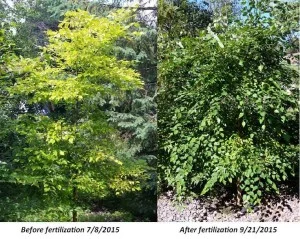Is Tree Fertilization Right For My Trees?
Soon it will be spring and time to begin our spring fertilization program. You may be wondering if tree fertilization is right for your trees. The answer to that question can be complicated, but I am here to simplify things.
Trees in the urban landscape face a number of unique challenges that can limit their growth and potential; they also face an increased mortality rate before reaching maturity.
What challenges do urban trees face and how can fertilization benefit?
Nutrients
In the forest there is a natural process of decomposition that constantly recycles nutrients. In the urban environment, debris is cleaned up and there is little if any nutrient recycling. We use a slow (microbial) release fertilizer which mimics the natural process of decomposition. Research shows an increase in the rate of growth of fertilized versus non-fertilized trees. This is especially true for small to medium sized trees in the vigorous phase of growth. Large mature trees are in a slower phase of growth but also benefit from the additional nutrients.
Competition
Young trees are working hard to grow and become established. They are also in direct competition with turf grass roots for space and nutrients. Research indicates that height and trunk caliper growth is slower than trees grown in bare soil or wood mulch. Leaf canopy is also noticeably thinner on trees grown in turf grass. We use a soil probe to inject the fertilizer into the ground, placing it beneath turf grass roots where trees will get the most benefit. The addition of tree fertilizer promotes the development of fine absorbing roots.
Compaction
Soil compaction is unavoidable in the urban environment. Foot traffic, lawn mowers and even irrigation systems all contribute to compaction. The main problem with compaction is it reduces micro pore space in the soil which holds oxygen. Trees fine absorbing roots require oxygen and are negatively impacted by compaction. Our soil injected fertilization program can reduce some compaction, but there’s no best way to dramatically reduce it. If possible mulching the entire area beneath a tree with wood mulch can reduce further compaction and improve soil structure in time.
These are just a few of the challenges urban trees face. The main point is everyone would like to have a large shade tree at their home. Trees provide many benefits to the environment and increase our quality of life. Fertilization is one of the many practices which help trees overcome the challenges found in the urban environment.
David Anderson; Plant Health Care, Shadywood Tree Experts ISA Arborist


